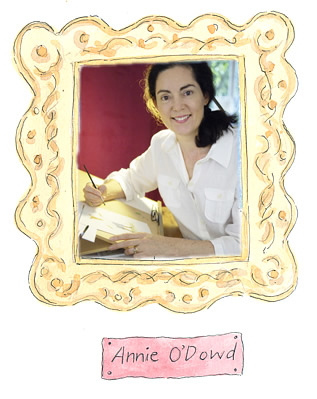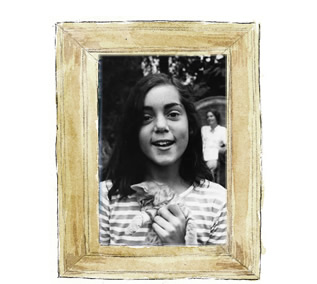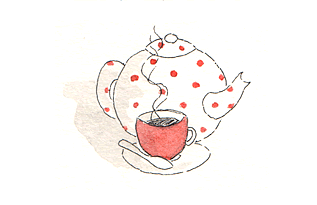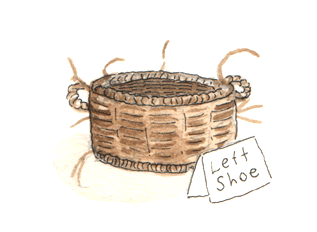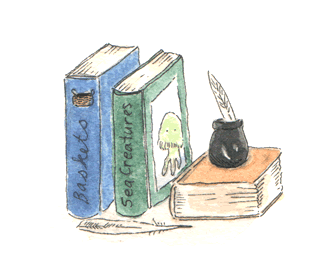 |
 |
 |
 |
 |
 |
 |
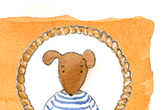 |
| Annie
O’Dowd grew up as one of the five Henderson kids on a sheep
station called ‘Mahrigong,’ fifty-six miles from Winton
in Queensland. The outback landscape was dry, brown and vast with
the horizon spanning every degree of the compass. Annie wrote her
first stories under the tin roof of the tiny Mahrigong State School,
an isolated classroom on the family property with one teacher and
16 pupils. The school lay just beyond the homestead's back ramp, and a little past the clothesline. It had the usual rows of wooden desks, a concrete floor and a blackboard. The most exciting piece of furniture was a tall stationery cupboard which had a harrowing display on the very top- a collection of glass jars full of snakes! The school curriculum included Friday afternoon sewing classes with Annie’s mother or a swim in the Forster’s brown dam. The other pupils came from the neighbouring properties and a few had to travel as far as 30 miles to school in a little bus. Some lived a little closer, including the boy who rode 10 miles to Mahrigong on a small motorbike, at the tender age of 8. There were always fun things to do around the property - a cranky Shetland pony to ride, milking to watch and pigs to worry. Annie’s father would often take a mob of kids with him to check troughs, paddocks and fences. Annie and her brother and younger sister loved to walk to the dump, about a mile and a half away. The dump wasn’t like a smelly city landfill. It was home only to the treasures of history- rusting iron stoves, farm machinery, car bodies, and parts from other gadgets of unknown origin. There were chores to do as well- collecting the eggs, taking down the pig bucket and of course, the scourge of childhood - wiping up the dishes! Later, when the family had moved to Brisbane to escape the drought, Annie would often think of the ancient purple hills behind Winton. They rose on the horizon, worn low over millions of years, changing colour according to the time of day. The landscape of childhood, once in place can never be forgotten. To Annie and her brothers and sisters, Brisbane couldn’t have been stranger. Although they had often visited grandparents there, it wasn’t the same as making it home. The humid green spaces, redolent with rotting mangoes and the hiss of possums, were like another world. Leafy suburbia and the blue rectangles of back yard pools replaced outback arid browns. City life, with its sweet shops and television still retained, even then in the 1970’s, a very old fashioned feel. Brisbane was a country town, dead on a Saturday afternoon and sleepy with summer’s dull heat. In this environment, Annie spent a happy adolescence. She attended a girl’s school up the road from her house. There, Annie’s interest in theatre and speech and drama was nurtured and she involved herself as much as possible in every play and performance available. During this time, she illustrated her school books for the amusement of her friends, and made her first careful watercolours. She started a couple of stories for children as well, writing her first at the age of twelve. This was about a child inventor, and badly pecked out with an old typewriter. Her English teacher quietly encouraged Annie to submit her drawings and stories for publication in the school magazine. Annie spent all her weekends and school holidays with her best friend on an island in Moreton Bay. Although the seadogs had not yet come into being, this was their birthplace. The scribbly Banksia and Casuarina trees, the green bracken undergrowth and the sand, became home to Left shoe and Marigold. When Annie left school a couple of years later, she began a course in Kindergarten teaching and six months later, left for America on an AFS exchange scholarship. When Annie returned the following year, she decided to change course and left Brisbane to study theatre in Toowoomba. After graduation, Annie worked with the Queensland Theatre Company, La Boite, The Fluba Troupe, and Darwin Theatre Group. In between jobs, she waitressed, made coffee, poured drinks, performed singing telegrams, nannied, kept shop, made greeting cards and did what ever job came to hand. At around this time, Annie found happiness. Across a crowded rehearsal room, she spied her future husband, Stephen O’Dowd while practicing the dance steps for ‘We Can Work it Out’. They married in 1988 and now have three big children - Thomas, Imogen and Kitty. Annie returned to study for her teaching letters, and in 1989 embarked on her next career as a speech and drama teacher. Annie now teaches the AMEB syllabus to a gaggle of girls at two Brisbane schools. Almost 5 years ago, Annie and Stephen took their three children on an adventure to rural England. For two and a half years, they lived in a little village in Kent. The family became involved with various village pastimes - riding horses, church nativity plays, local pantomimes and various school fundraising events. When the O’Dowd Family returned to Australia in late February 2003, there were no teaching jobs about. Annie decided that she would try to find work as an illustrator. A self- taught artist, she produced some watercolours and submitted them to publishers. Among these drawings were the seadogs. That was when Annie decided to write the tale of Left Shoe. ‘Left Shoe and the Foundling’ (book 1) and ‘Marigold and the Dark,’ (book 2) were published in October 2005 by Pan Macmillan. Book 3, ‘Sea Gem and the Land of Ice’ (2006) followed and her latest seadog adventure, ‘Tumblegrass and the Bushfire’ (book 4) was released in 2008. In between looking after her family and teaching, Annie is quietly tapping out her next story on the computer. |
